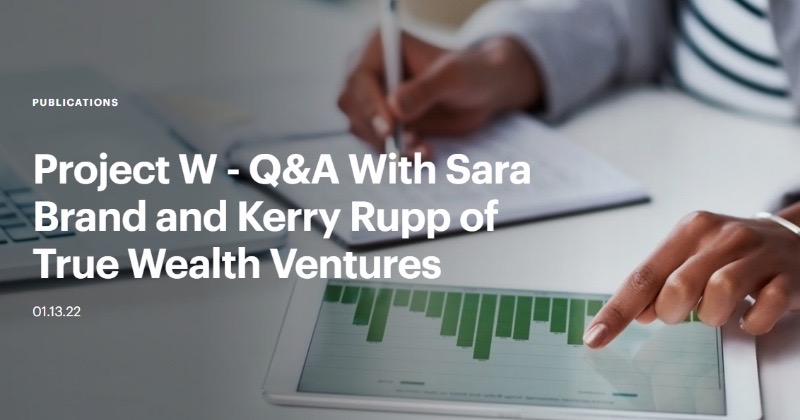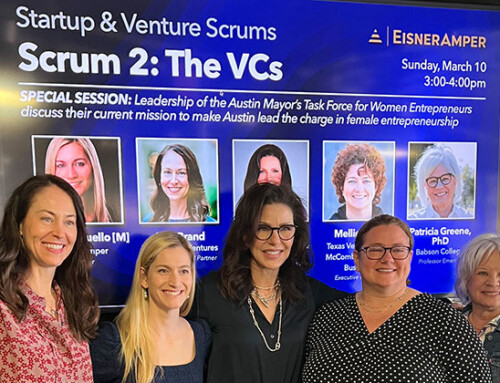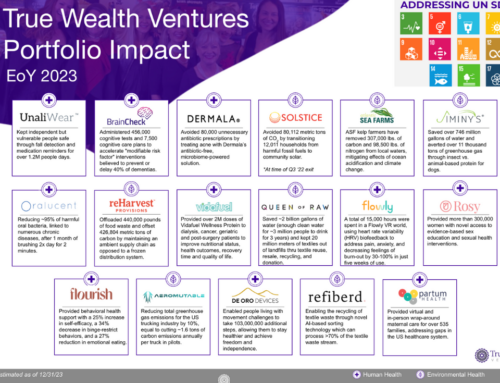As one of the first venture funds founded by women to invest in women, True Wealth Ventures is helping to pave the way for other VC firms working toward better gender equity in their firms and who they’re investing in.
Q: True Wealth Ventures was one of the first venture funds founded by women to invest in women. What prompted you to pioneer this field?
Sara: I was in a big corporate tech company when I was asked to be the executive sponsor of their global women’s forum as the only woman VP with a technical or operating background at the time (late 2011). I did some homework as I was considering what to do about this ask and came across a McKinsey study showing that corporations with the most women in senior leadership saw significantly higher financial returns and operating margins. Knowing I wanted to get back into venture capital, I eventually started investigating the dynamics in that industry and found the same financial outperformance for women-led, VC-backed companies, but an even bigger gap in terms of the lack of women at VC firms making the investment decisions and a lack of women entrepreneurs receiving VC investment dollars. It was the best business opportunity I had ever seen and combined everything I loved into one job.
Kerry: When Sara verbalized to people in the Austin ecosystem that she’d never met another woman in venture capital (even when mingling at VC networking events in the Bay Area), several Austin investors pointed her to me as “the other woman in VC.” When we got together, we thought that was hyperbole, but it turned out we were the only women general partners in a VC firm in Texas for the next several years. At the time, I was CEO of DreamIt Ventures, a top accelerator where I had run programs focused on women entrepreneurs, minority entrepreneurs, and health tech entrepreneurs and was investing out of a $20M seed-stage fund we had raised. So, I knew first-hand the value of a fund focused specifically on women-led companies improving human and/or environmental health and felt compelled to join forces with Sara at True Wealth Ventures.
Q: Your investment thesis is based on the power of women – to solve problems, to build great teams, and to exercise their consumer buying power strategically. Tell us about your thesis and how it developed.
Our investment thesis is to exclusively invest in women-led companies that are improving environmental or human health. As mentioned previously, women-led companies financially outperform across the board. But we also saw that women were making an estimated 85% of consumer purchase decisions and 80% of health care decisions. So, our thesis for Fund I was that we expected an even greater financial outperformance from gender-diverse teams that were in the markets dominated by women decision makers as they have advantaged insights into the customer and market requirements. For Fund I we required that the company’s product or technology had consumer or patient pull-through into the market to take advantage of the women decision makers. However, over the life of Fund I we saw a number of companies that didn’t necessarily have that consumer transparency but were still significantly improving environmental or human health in potentially even a more scalable fashion with a B2B go-to-market. So, for Fund II, we removed the consumer transparency requirement and are simply investing in women-led companies whose core value proposition is improving either environmental or human health.
Q: The stereotypical VC invests in many companies hoping for one unicorn. What do you look for in the companies in which you invest and how do you evaluate their potential for delivering meaningful returns for your LPs?
We do have a unique investment approach compared to most early-stage VC funds that are expecting the one unicorn to return their entire fund. We back into what we’re looking for – starting from looking at the profile of the most common exit. The most common exit for a VC-backed startup is via an acquisition, not an IPO. Most acquisitions happen after the seed or Series A investment rounds, which are considered “early stage.” And the most recent numbers from Pitchbook put the average acquisition valuation at a little less than $100 million. So, if most VC-backed startups are going to exit at a valuation a little south of $100 million, we want to be aligned with the entrepreneurs who are excited about that exit valuation as well. To be excited about that level of a valuation at the time we invest, we need to make sure that the company doesn’t have to raise big rounds or more than a few rounds in order to return the expected investment multiples to our LPs. So, we make sure that we are aligned with the founders at the time of our seed-stage investment in seeing a capital-efficient path to that most common acquisition valuation range. We also make sure that there are identified potential acquirers from the get-go and understand what and why they acquire so we can help build the company value for that eventual exit.
Q: Elsewhere in this newsletter we discuss some of the reasons institutional LPs rarely invest in first or second funds raised by women VCs. What do you think it will take for institutional investors to overcome their reluctance to invest in emerging women managers?
- First, truly engage in programs focused on new and diverse managers by dedicating resources to diligence and invest smaller size checks into newer, smaller, and more diverse funds. Their resulting return rates should be higher, and by helping to scale these funds, they can help grow these financially outperforming opportunities.
- Incorporate a new set of criteria to assess the viability of the new firms’ GPs (beyond exited track record). These criteria should include the GPs’ technical, operational, and entrepreneurial accomplishments, which may have better correlations with choosing successful portfolio companies and supporting them to a successful exit.
- Challenge established VC funds by demanding more transparency from all GPs into their diversity strategy — such as requiring performance metrics on the gender impact of their investments. We proposed how gender impact could best be standardized and measured in this Kauffman Foundation-funded work we have been supporting, both in the number of women partners making investment decisions at the VC funds and women-run portfolio companies.
Q: What advice would you give women who have never put money into a startup or venture fund but are thinking about taking that first investing step?
- First, you need to get invited or ask to invest as VC funds are not allowed to market publicly.
- You must be an accredited investor, as defined by the SEC, to invest in a venture capital fund.
- You should understand what the minimum investment commitment is.
- You should also understand the capital call structure. Funds do not take the entire investment amount up front (though once committed, you are contractually obligated to invest it). They “call capital” over time as needed to invest in the companies. For example, in our second fund, it will take us four to five years to select the 15 companies and make the first investments in those companies, and then we expect to make follow-on investments in most of those same companies several years after the first investment. Our model is to call capital quarterly, and we don’t expect to call more than 20% of the committed amount per year. You can roughly think of it as paying an average of less than 5% of your committed capital per quarter for the first five to seven years. That is often a lot easier to manage from a cash-flow perspective than one large upfront payment. All funds have different capital call strategies, so this is important to investigate.
- You can ask if the VC fund can take retirement funds. There are a lot of new tools in this space, and our fund, for example, can take a self-directed IRA where you can roll over IRA or 401k funds into a new self-directed IRA fund to invest.






